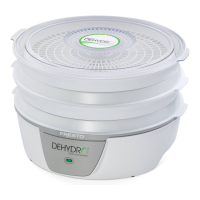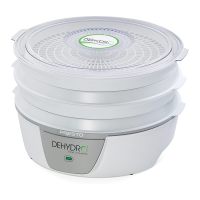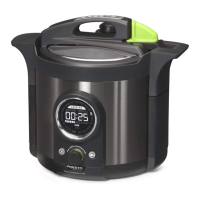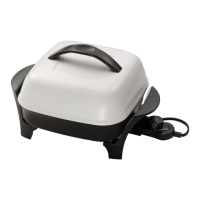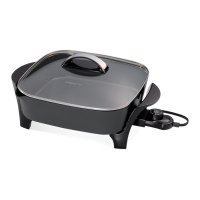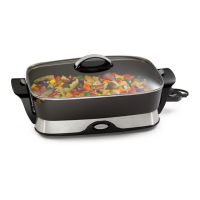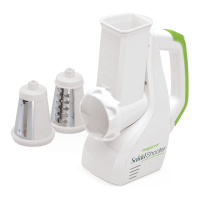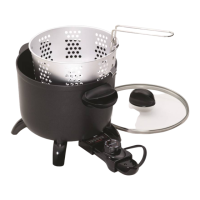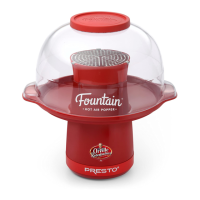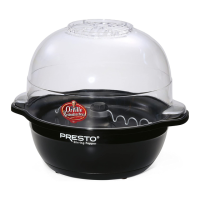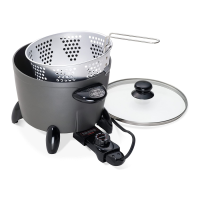4
Drying Meat/Poultry
Homemade jerky is a avorful dried meat product that is especially popular with outdoor sports enthusiasts because it is light and easy
to transport. Jerky can be made from most lean meat, including beef, pork, venison,
‡
or poultry. Basic food safety precautions need to
be observed when preparing and dehydrating meat/poultry:
• Wash hands thoroughly before and after handling raw food.
• Keep product refrigerated or frozen until ready to use.
• Raw meat/poultry and its juice should be kept away from other foods. Wash cutting boards, utensils, counters, etc. with hot, soapy
water after contact with raw meat. After washing, sanitize with a solution of 1 tablespoon chlorine bleach per gallon of water and
allow to air dry.
• Marinate meat/poultry under refrigeration. Discard marinade after meat/poultry is removed.
• Keep raw meat/poultry and dried jerky separate.
CAUTION! The United States Department of Agriculture (USDA) recommends that meat/poultry be precooked prior to dehydrating or
baked after dehydrating to reduce the risk of foodborne illness.
Preparing Jerky from Meat/Poultry Strips
Select lean meats such as beef and venison sirloin, rump, and round cuts; pork loin and ham cuts; and poultry breast, thigh, and leg.
Trim meat of visible fat, connective tissue, and gristle. Remove skin and fat from poultry. Freeze meat/poultry until rm, but not solid,
to make slicing easier. Slice into strips that are ¼ inch thick, 1 inch wide, and 5 to 6 inches long. Slice across the grain for a more
tender jerky or with the grain for a chewier jerky.
Flavor the meat/poultry strips by marinating in your own favorite marinade, a commercial marinade, or use the marinade recipe on
page 9. Place marinade and strips in a resealable plastic storage bag. Seal bag and shake to thoroughly coat the strips. Refrigerate for 8
to 12 hours. Turn bag often to evenly coat the strips.
Refer to the CAUTION! note above about cooking the meat/poultry before or baking after dehydrating. For a more desirable texture,
bake after dehydration. Meat/poultry that is precooked will have shorter drying times, but the end product will have a dry, crumbly
texture. If cooking the meat before dehydrating is preferred, follow the instructions below:
Cooking before dehydrating—After marinating, place strips and liquid marinade into a shallow pan. If no liquid remains, add
enough water to cover strips. Bring liquid to a boil and boil for 5 minutes.
Remove strips from marinade and place in a colander to drain. Pat strips dry. Then position them on dehydrator trays. Arrange strips
close together but not overlapping.
The average drying time will be 4 to 8 hours. See “Determining Dryness” information below.
If you did not cook the meat/poultry prior to dehydrating, bake it after, following the instructions below.
Baking after dehydrating—Preheat oven to 275°F. (For an accurate temperature reading, check with an oven thermometer.)
Remove jerky strips from dehydrator trays and place on a baking sheet close together, but not touching. Heat jerky in preheated
oven for 10 minutes (jerky strips should be sizzling when removed from the oven). Remove jerky from baking sheet and cool to
room temperature.
Preparing Jerky from Ground Meat
Mix 93% lean ground meat with your favorite commercially available jerky seasoning and cure, using the instructions provided on
the seasoning/cure package. Place the ground meat mixture in a Presto
™
jerky gun
*
or a cookie press and extrude meat directly onto
dehydrator trays, making sure that the meat does not touch or overlap.
Dry jerky for 4 to 8 hours. See “Determining Dryness” information below. Bake the meat after dehydrating, following the instructions
above.
Determining Dryness
Begin checking jerky after about 4 hours and every 30 minutes thereafter. Drying time will depend on a variety of factors. These factors
include the type of
meat/poultry
, the amount of fat, and whether or not it was precooked before dehydrating. In addition, times will
vary depending on size/thickness of the pieces and how full the trays are. Jerky that is acceptably dry will crack when bent but will not
break.
‡
Venison or wild game meat that has been contaminated with entrails should not be used for making jerky.
*
Presto
™
Jerky Gun sold separately (see page 14).
